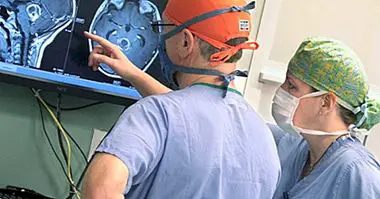Aprosodia: types and symptoms of this language deficit
Speech has its rhythm and its times . When we speak we do not just let go of an idea, we separate the words, we give more emphasis to some than to others and we structure our discourse. We pause and give an intonation and a melody that make communication an understandable flow of information in various aspects. This is derived from a large number of aspects, including emotionality and the sense of rhythm.
The prosody can be trained and is usually acquiring a greater wealth and skill in it as we learn. But some people, for different reasons, or fail to achieve this learning or even if they have lost it as a result of some type of brain injury. These people present aprosodia , a phenomenon of speech that can lead to communication difficulties. Let's see what it consists of.
- You may be interested: "The 8 types of speech disorders"
What is aprosodia?
The aprosodia is considered a deficit or inability to understand and / or produce changes in the tone of the voice, rhythm or intonation . It is an alteration of one of the main verbal aspects of language, that is, one of the elements that allow us to vary the acoustics of the message we provide and that can have different effects on the message itself.
Considering that prosody allows us to provide information with emotional meaning, qualify or even imply the opposite of what is expressed, and also makes the message much more understandable to the recipient, we can consider that a person with aprosodia goes to show an inability to reflect your emotions in your voice, regulate the tone of voice or control the times and rhythms of speech , resulting in his speech much more difficult to interpret.
Your message will be much flatter, not knowing exactly what you want to emphasize unless you indicate it explicitly. Definitely, the speech of someone suffering from aprosodia tends to be monotonous and neutral . In some cases, you may not separate the words or phrases well, making comprehension even more complicated.
It will also have greater difficulty or even it can be difficult to understand elements such as changes in the voice of other people and what it may involve regarding the message. There may be difficulties in capturing emotions. But we are not before subjects who lack the ability to express their thoughts or have no emotions.
Neither are people who have to have any intellectual deficit or a neurodevelopmental disorder (although it often appears in some of them). They simply are not able to print their language of the intonation, the rhythm and the emotional meaning what other people do.
As a problem that affects communication, it can have different effects on the life of the sufferer. Although in itself it is not usually a serious limitation that prevents social participation or the performance of any action, the person can be seen as cold and strange . Their way of expressing themselves can lead to misunderstandings and discussions, which can cause some type of social rejection or even some difficulty at work. It is likely that there is an avoidance on the part of the affected party to start or maintain conversations.
Types of aprosodia
Not all subjects with aprosodia have the same difficulties. In fact, at the time the concept was proposed, the existence of different typologies was also proposed depending on the affected brain localization . Considering this aspect, we can find different typologies, but three main types stand out.
1. Sensory aprosodia
In this type of aprosodia the problem is at the level of understanding. The subject has severe difficulties at the time of understand and process changes in rhythms and intonation of others , may cost him to recognize the emotions of the recipients.
2. Motor aprosodia
In this type of aprosodia the problem is fundamentally the expression: as we have said before the subject has a monotonous language and lack of emotionality , not being able to modulate the voice correctly so that it offers information beyond the content of the message in question and / or not controlling the rhythm. It is also common to have a certain silence, facial rigidity and lack of gesticulation.
3. Mixed aprosodia
In this case, the two types of previous difficulties occur together.
What are your causes?
The causes of aprosodia can be multiple, but can usually be found in the presence of neurological alterations or injuries .
The different investigations carried out indicate that these lesions would be found generally in the temporal and parietal lobes of the right hemisphere of the brain, linked emotional expression and the use of rhythm.Specifically, the damage would correspond especially to the area of Broca and the Wernicke area of said hemisphere. It is a very common disorder in the clinical population, especially in those who have some type of aphasic problem.
These injuries can occur due to multiple conditions. It is frequent to appear before traumatism cranioencephalic , cerebrovascular accidents or neurodegenerative processes such as dementia (for example, it is common in dementias caused by Alzheimer's disease and Parkinson's).
It is also common and very characteristic of subjects with autism spectrum disorder. Likewise, aprosody appears associated with the consumption of substances such as alcohol, as in subjects with dependence to said substance or those subjects with fetal alcohol syndrome. Finally, it can appear in mental disorders such as schizophrenia, or in some cases in people who have experienced severe traumas.
Possible treatments
The aprosodia approach is usually multidisciplinary. Keep in mind that in most cases we are talking about the consequence of a brain injury, so that must be taken into account first what caused it .
One of the main strategies is to apply speech therapy techniques and treatment using modeling and techniques based on imitation in order to reduce their communicative limitations. It is also frequent that biofeedback is used, especially in the motor type. The work on emotional expression through different ways can also be very useful. Psychoeducation and information are also important in order that the person and the environment can understand what is happening and know how to take it and understand it.
Bibliographic references:
- Ardila, A .; Arocho, J.L .; Labos, E. & Rodríguez, W. (2015). Dictionary of Neuropsychology.
- Leon, S.A. & Rodríguez, A.D. (s.f.). Aprosodia and Its Treatment. American Speech Language Hearing Association. Florida.
- Stringer, A. Y. (1996). Treatment of motor aprosodia with pitch biofeedback and expression modeling. Brain Inj., 10, 583-590.



















